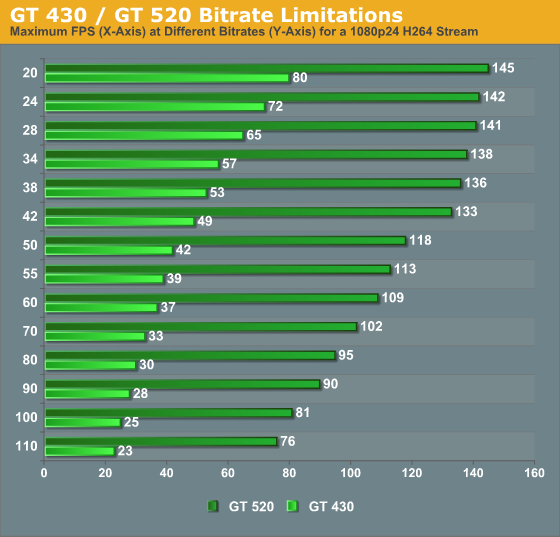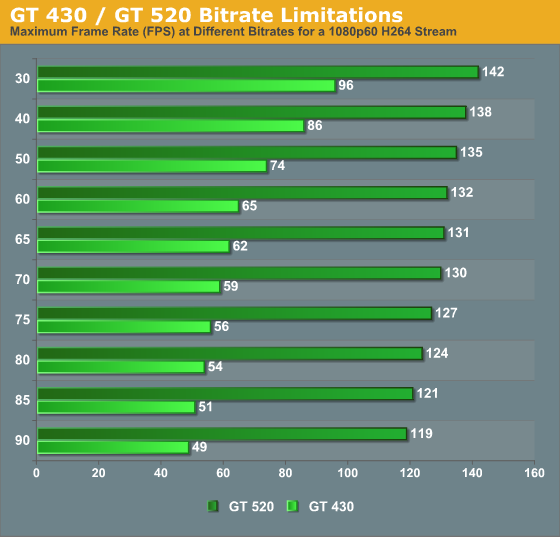Discrete HTPC GPU Shootout
by Ganesh T S on June 12, 2011 10:30 PM ESTIn the previous section, I mentioned about the bitrate limitations of the GT 430 when decoding 1080p H264 clips. NVIDIA confirmed that the GT 430 couldn't decode 60 fps videos at 80 Mbps. This piqued my curiosity and I tried out a few experiments to find out whether bitrate limitations exist for the usual 1080p24 videos on both the GT 430 and GT 520.
The DXVA Checker benchmark was repeated for all the bitrate testing files found in the NMT test files upto 110 Mbps.

We also created our own suite of bitrate testing streams at 1080p60. Running them through the DXVA Checker benchmark yielded the following results.

The results are presented in a bar chart above (A line chart would have made much more sense, but the outer values get placed only for bar charts in our graphing engine). For 1080p24 streams, we find that the GT 430 is unable to keep up with the real time decode frame rate requirements at 110 Mbps. For 1080p60 streams, the limit gets further reduced to somewhere between 65 and 70 Mbps. The GT 520 has no such issues.
The above testing is only of academic interest, since there is no real 1080p24 content at 110 Mbps. Even 3D Blu-rays max out around 60 Mbps (and that includes the audio stream!), so users shouldn't really be concerned about this bitrate limitation of the GT 430.
The GT 520's scores above are more interesting. Even the high end GPUs such as the 460 and 560 are unable to achieve that frame rate. The answer was buried in the README for the latest Linux drivers. The GT 520 is the first (and only GPU as of now) to support the VDPAU Feature Set D.
We asked NVIDIA about the changes in the new VDPAU feature set and what it meant for Windows users. They indicated that the new VPU was a faster version, also capable of decoding 4K x 2K videos. This means that the existing dual stream acceleration for 1080p videos has now been bumped up to quad stream acceleration.
Though the GPU can decode 4K videos, it is unfortunately not able to output it through HDMI. Despite the HDMI controller being advertised as HDMI 1.4a, it doesn't implement the 4K x 2K resolution part of the standard. The lack of HDMI sinks which accept that resolution is another matter, but that should get resolved in the next few years.
Despite the GT 520's advanced VPU engine, the lack of shaders limits its post processing capabilities. With all post processing options enabled, the GT 520's GPU load was always between 60 and 80%. The memory controller load (DRAM bandwidth usage) was between 20 and 40%. Despite the headroom apparently available, NVIDIA indicated that there weren't enough shaders available to implement the more advanced deinterlacing algorithms.










70 Comments
View All Comments
ganeshts - Thursday, June 16, 2011 - link
PotPlayer apparently doesn't have support for hardware deinterlacing, and has a host of other issues [ Search for PotPlayer in this page and then read the next set of posts about it : http://www.avsforum.com/avs-vb/showthread.php?p=20... ].Of course, if it works for you, it is great :) (probably it is a good solution for people watching progressive material only).
The author of LAV CUVID talks in that thread about how renderless DXVA mode works with madVR at the cost of deinterlacing.
Btw, there is no decode of DTS-HD in any open source software now. Both ffdshow and PotPlayer can decode only the core DTS soundtrack. DTS decode has been around for a long time, though.
NikosD - Saturday, June 18, 2011 - link
Indeed, I was referring to progressive material only - interlaced material is rare - but the page you mentioned says PotPlayer has CPU deinterlacing.I don't see where is the problem.
Hardware Deinterlacing is less important - for most users - than Hardware Decoding (DXVA) and less important than the UNIQUE capability of using DXVA + madVR at the same time.
The cost of hardware deinterlacing is nothing compared to the cost of DXVA and madVR.
For the audio part of your answer, I have to say that because of my AVR (Pioneer VSX-920) decoding inside a PC, BluRay, Media Player or any other decoding capable device of multi-channel audio is never an option for me.
I always prefer the bitstreaming solutions for multi-channel audio - as most of the owners of AVR do - like those provided by FFDshow and PotPlayer which both are more than capable of providing them.
That's why I wrote "decoding and pass-through", I had to write "splitting and pass-through".
One last word.
For every piece of software out there, there is always a list of changes, bugs, things to do.
That doesn't mean we don't use it or like it.
PR3ACH3R - Friday, June 17, 2011 - link
@Ganesh T S,This is some NICE work.
In fact, I cannot recall when was the last time I have seen such an in depth article on the HTPC GPU subject in Anandtech.
The balance between the technical issues, the background, & the effort to honestly report all issues known to you in this article, is spot on.
If it is missing something on the issues report, it misses on the ATI/AMD DPC Latency spiking issues.
As this is still remains unnoticed in Anandtech even in this excellent article, here is a link to the AVS post describing it.
http://www.avsforum.com/avs-vb/showthread.php?t=12...
(Ignore some of the discredit attempt posts in this thread, this problem exists to this very day.)
NikosD - Thursday, June 23, 2011 - link
Well, I did some further tests and found out that PotPlayer does have hardware deinterlacing.Have you done any tests by yourself to see if the player supports Hardware Deinterlacing ?
ganeshts - Saturday, June 25, 2011 - link
NikosD, I will definitely try PotPlayer out in the next GPU review. Till now, my knowledge is limited to what is there in the AVSForum thread.flashbacck - Friday, June 24, 2011 - link
I know HTPCs are even more of niche these days than ever, so I appreciate you still doing these tests very much.wpoulson - Thursday, July 28, 2011 - link
I really appreciate this guide and have been stepping through itI just registered the ASVid.ax file from TMT5 but the filter is not showing up in the External Filter section of MPC-HC. At first I thought it might be because I registered it on the 32 bit side and I'm using 64 bit MPC-HC, so I unregistered the file from System 32 and registered it on the 64 bit side.
I registered it by going to Start>CMD>Cntrl-Shift-Enter and using the "Regsvr32" command to register the file. I put the file along with the checkactivate dll in a folder in the root directory of my C drive and pointed the Regsvr command to the ASVid.ax file. After hitting enter, I received a "dll successfully registered" message.
Can someone help me to get the filter visible for MPC-HC?
A question...While it's considered beta, will the new LAV video decoder do the same thing the arcsoft video decoder does?
Thanks
Warren
stuartm - Friday, January 20, 2012 - link
I am aware the gt 430 is a good choice to work around the infamous WMC 29/59 framerate bug. Can you comment on whether or not the 6570 will stutter or not when playing content with 29/59 framerate problems? A very important consideration for those of us using ceton or HDHR Primes (or the new Hauppauge box) for cable TV Live viewing and record/replay.Thank You
MichaelSan1980 - Saturday, January 21, 2012 - link
I'd use my HTPC for DVD's and BD's only with an Full-HD TV. Since i have a rather strong CPU and wouldn't use Hardware Deinterlacing for DVDs, i wonder, if the GT520 is ~that~ bad, in terms of image quality?drizzo4shizzo - Wednesday, June 20, 2012 - link
Old guy here.In the market but I need confirmation that these cards can do component output to "old guy" HDTV.
NONE of the marketing materials suggest that any recent card can.
Meaning they either come with a component video breakout or at least are compatible with a known 3rd party product, and that they can do the RGB -> YUV thing.
This ancient EVGA 7600 GT I have does it... with an "svideo lookalike" 7 pin -> component breakout.
Anyone? Beuller?